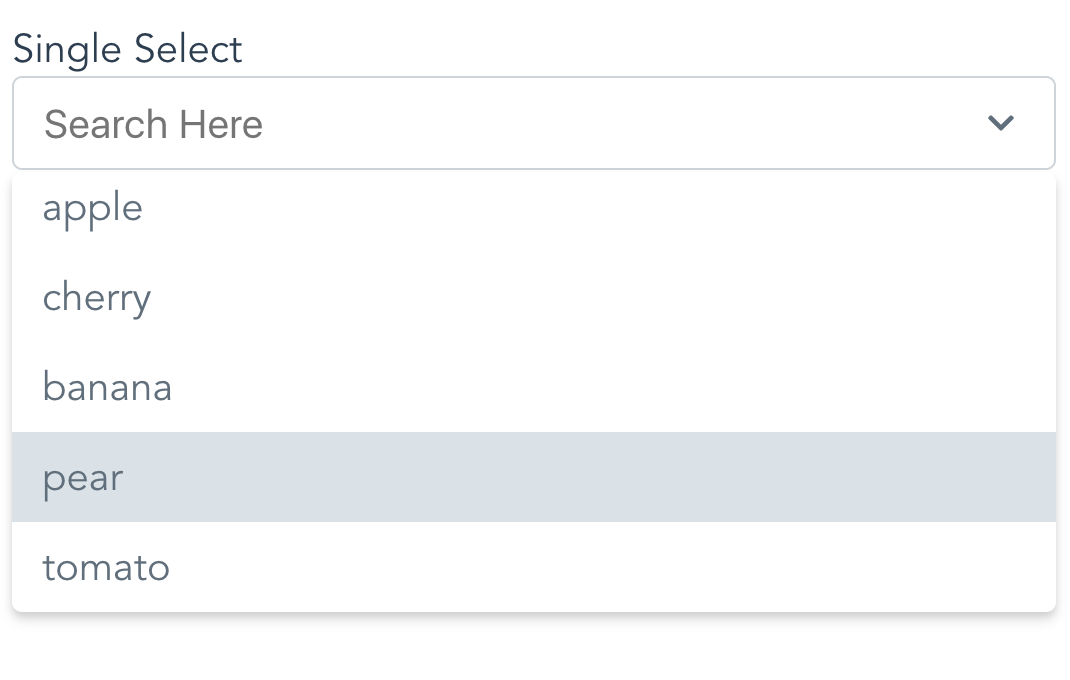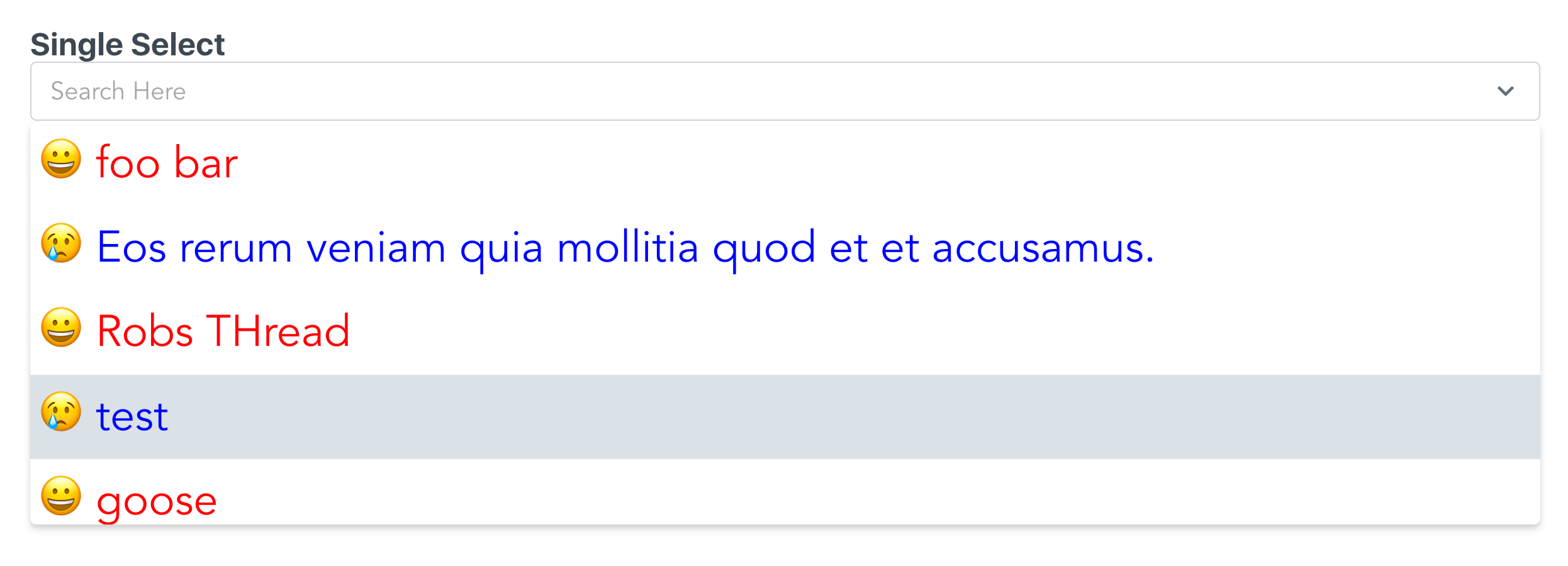vue-single-select
simple autocomplete select dropdown component for Vue apps for you!
Demo
What It Does
vue-single-select provides a simple component for making long, unwieldy select boxes more friendly, like Chosen for jQuery.
How Simple?
This simple
<vue-single-select
v-model="fruit"
:options="['apple','cherry','banana','pear', 'tomato']"
></vue-single-select> What It Does Not Do
Nope no Multi Select. See vue-taggable-select for this.
Install or Use Via CDN
<div id="app">
<label>Choose a fruit!</label>
<vue-single-select
v-model="fruit"
:options="fruits"
></vue-single-select>
</div><script src="https://unpkg.com/vue@latest"></script>
<script src="https://unpkg.com/vue-single-select@latest"></script>
<script>
new Vue({
el:"#app",
data: {
fruit: null,
fruits: ['peach','pear','apple','orange']
}
});
</script>Install Via NPM
$ npm i vue-single-selectRegister it
In your component:
import VueSingleSelect from "vue-single-select";
export default {
components: {
VueSingleSelect
},
//...
}Globally:
import VueSingleSelect from "vue-single-select";
Vue.component('vue-single-select', VueSingleSelect);Use It
<vue-single-select
v-model="fruit"
:options="['apple','banana','cherry','tomato']"
:required="true"
></vue-single-select>Use It Again
Specify a custom option label and option value
Here each option refereneces a post title in the posts list in data. The option value references a post id in the same list. Like:
posts: [{title: "ok dude", id: 1}, {title: "awesome dude", id: 2}, ...]
<vue-single-select
name="maybe"
placeholder="pick a post"
you-want-to-select-a-post="ok"
v-model="post"
out-of-all-these-posts="makes sense"
:options="posts"
a-post-has-an-id="good for search and display"
option-key="id"
the-post-has-a-title="make sure to show these"
option-label="title"
></vue-single-select>Use It Again
Specify a custom option label.
Here the Option Label references a reply the replies list in data. With a format like:
replies: [{reply: "ok dude"}, {reply: "awesome dude"}, ...]
<vue-single-select
you-want-to-select-a-reply="yes"
v-model="reply"
out-of-all-these-replies="yep"
:options="replies"
a-reply-only-has-a-reply="sounds about right"
option-label="reply"
seed-an-initial-value="what's seed mean?"
initial="seed me"
you-only-want-20-options-to-show="is 20 enough?"
:max-results="20"
></vue-single-select>Dont like the Styling?
You can override some of it. Like so:
<vue-single-select
id="selected-reply"
name="a_reply"
option-label="reply"
v-model="reply"
:options="replies"
you-like-huge-dropdowns="1000px is long!"
max-height="1000px"
you-love-bootstrap="yes!!"
:classes="{
input: 'form-control',
wrapper: 'form-group',
icons: 'glyphicon',
required: 'required'
active: 'active',
dropdown: 'dropdown'
}"
></vue-single-select>Then all you need to do is provide some class definitions like so:
.form-control {
color: pink;
width: 10000px;
_go: nuts;
}
.glyphicon {
display:none;
}
.form-group {
background-color: pink;
font-size: 16px;
}
.required {
color: #721c24;
background-color: #f8d7da;
border-color: #f5c6cb;
}
.dropdown: {
color: violet;
}
.active {
background-color: lemonchiffon;
}Note: Bootstrap 3 Users May want to increase the size of the icons.
If so do this:
.icons svg {
height: 1em;
width: 1em;
}See defaults below.
Dont like the styling at all?
Use the slots option to really mix it up.
This is a little advanced, but it's not too hard. Take a look:
<single-select
option-label="title"
v-model="thread"
:options="threads"
max-height="300px"
>
<template slot="option" slot-scope="{option, idx}">
<div style="display:flex;padding: 2px;font-size: 2rem;"
:class="idx % 2 ? 'emoji-happy' : 'emoji-sad'"
:style="idx % 2 ? 'color:red' : 'color:blue'">
<span style="margin-left: 1rem;">
{{idx}}</span>
<span style="margin-left: 1rem;">
{{option.title}}</span>
</div>
</template>
</single-select>.emoji-happy::before {
content:"\1F600"
}
.emoji-sad::before {
content:"\1F622"
}The key is the template element.
Here I give you the option and the current index. From there you can add html, add exta info, or a smiley face.
And here you go:
Kitchen Sink
Meh, see props below.
Why vue-single-select is better
-
It handles custom label/value props for displaying options.
Other select components require you to conform to their format. Which often means data wrangling.
-
It's easier on the DOM.
Other components will load up all the options available in the select element. This can be heavy. vue-single-select makes an executive decision that you probably will not want to scroll more than N options before you want to narrow things down a bit. You can change this, but the default is 30.
-
Snappy Event Handling
- up and down arrows for selecting options
- enter to select first match
- remembers selection on change
- hit the escape key to, well, escape
-
Lightweight
- Why are the other packages so big and actually have dependencies?
-
It works for regular 'POST backs' to the server.
If you are doing a regular post or just gathering the form data you don't need to do anything extra to provide a name and value for the selected option.
-
Mine just looks nicer
-
It's simple!!
Available Props:
There are more props than I'd like. But I needed them so you might too.
props: {
value: {
required: true
},
// Give your element a name.
// Good for doing a POST
name: {
type: String,
required: false,
default: () => ""
},
// Your list of things for the select
options: {
type: Array,
required: false,
default: () => []
},
// Tells vue-single-select what key to use
// for generating option labels
optionLabel: {
type: String,
required: false,
default: () => null
},
// Tells vue-single-select the value
// you want populated in the select for the
// input
optionKey: {
type: String,
required: false,
default: () => null
},
placeholder: {
type: String,
required: false,
default: () => "Search Here"
},
maxHeight: {
type: String,
default: () => "220px",
required: false
},
// Give your input an html element id
inputId: {
type: String,
default: () => "single-select",
required: false
},
//Customize the styling by providing
//these FIVE custom style definitions.
classes: {
type: Object,
required: false,
default: () => {
return {
wrapper: "single-select-wrapper",
input: "search-input",
icons: "icons",
required: "required",
activeClass: 'active',
dropdown: 'dropdown'
};
}
},
// Seed search text with initial value
initial: {
type: String,
required: false,
default: () => null
},
// Disable it!
disabled: {
type: Boolean,
required: false,
default: () => false
},
// Make it required
required: {
type: Boolean,
required: false,
default: () => false
},
// Number of results to show at a time
maxResults: {
type: Number,
required: false,
default: () => 30
},
// meh...
tabindex: {
type: String,
required: false,
default: () => {
return "";
}
},
// Tell vue-single-select what to display
// as the selected option
getOptionDescription: {
type: Function,
default: function (option) {
if (this.optionKey && this.optionLabel) {
return option[this.optionKey] + " " + option[this.optionLabel];
}
if (this.optionLabel) {
return option[this.optionLabel];
}
if (this.optionKey) {
return option[this.optionKey];
}
return option;
}
},
// Use this to actually give vue-single-select
// a value for doing a POST
getOptionValue: {
type: Function,
default: function (option) {
if (this.optionKey) {
return option[this.optionKey];
}
if (this.optionLabel) {
return option[this.optionLabel];
}
return option;
}
},
//Default filtering, provide your own for fun
//Like startsWith instead of includes
filterBy: {
type: Function,
default: function (option) {
if (this.optionLabel && this.optionKey) {
return (
option[this.optionLabel]
.toString()
.toLowerCase()
.includes(this.searchText.toString().toLowerCase()) ||
option[this.optionKey]
.toString()
.toLowerCase()
.includes(this.searchText.toString().toLowerCase())
)
}
if (this.optionLabel) {
return option[this.optionLabel]
.toString()
.toLowerCase()
.includes(this.searchText.toString().toLowerCase())
}
if (this.optionKey) {
option[this.optionKey]
.toString()
.toLowerCase()
.includes(this.searchText.toString().toLowerCase())
}
return option
.toString()
.toLowerCase()
.includes(this.searchText.toString().toLowerCase())
}
}
}Q&A
Q. What about Ajax?
A. Good question. Why aren't you passing data in as a prop? Seriously, this is just a widget why does it need knowledge of it's data source?
Q. How do I change how items are filtered?
A. Easy. See prop above, matchingOptions. Just override it with your own method as a prop.
Q. What about Templating?
A. What about it? Just use the new scoped slots!
Q. What about Multiple Selects?
A. Nope not found here. See vue-taggable-select
Q. Can I trust this?
A. Yep. It's backed by tests using jest and vue test utils.


